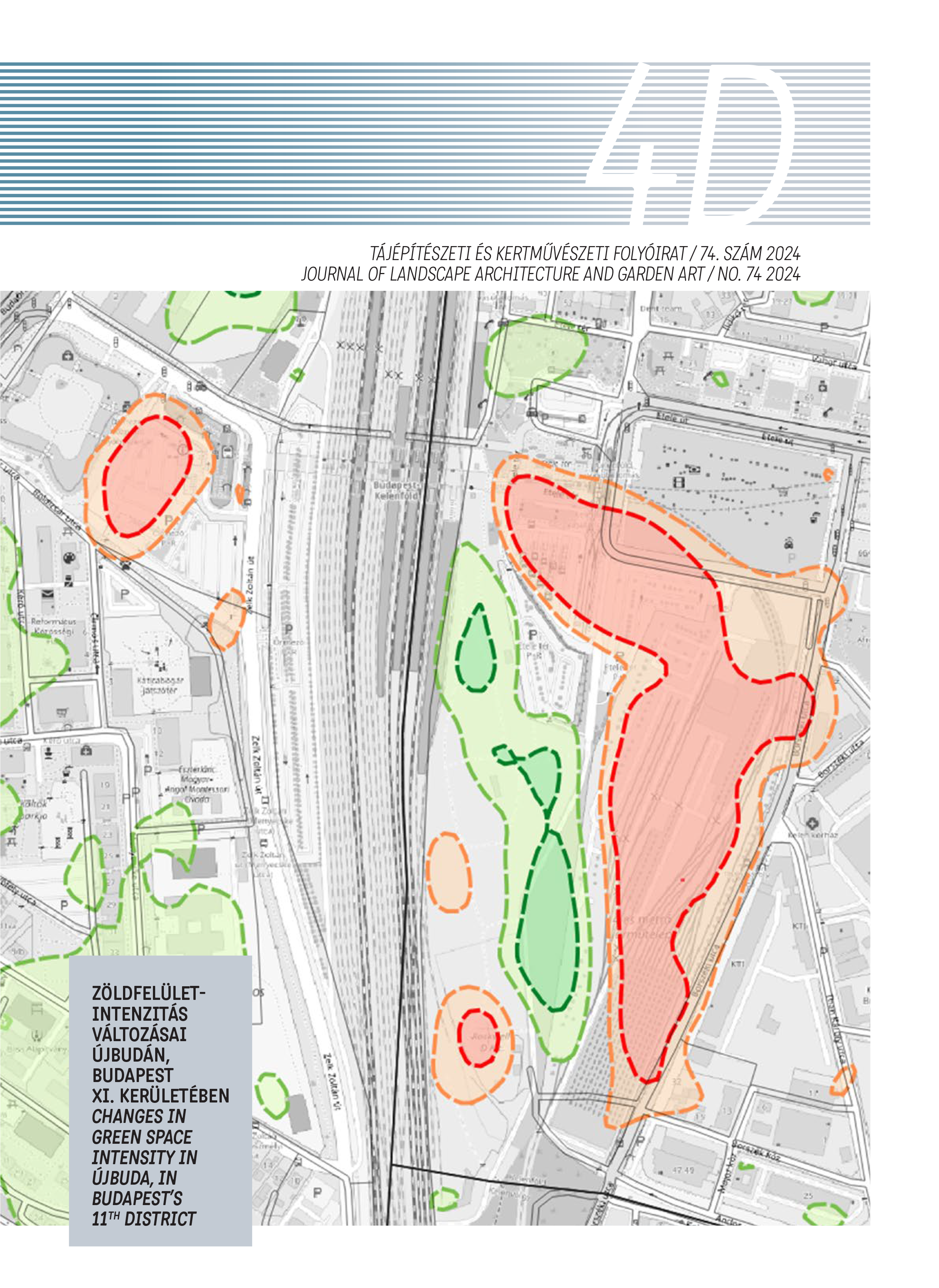Methodological possibilities for determining the ecological network
DOI:
https://doi.org/10.36249/4d.74.5952Keywords:
connectivity, ecological network, fragmentation, habitat suitability, landscape ecology, landscape metrics, gis modellingAbstract
An ecological network as a biodiversity and habitat conservation tool, maintaining the material and energy cycle, is a coherent system of natural and semi-natural landscape elements. It can be divided into three basic structural units: core areas, ecological corridors and buffer zones, which are sometimes supplemented by rehabilitation areas. Our research on planning methods and definition of the ecological network has revealed different approaches and influencing factors. We have identified that a network can aim to improve the living conditions of a species (or group of species), or it can aim to improve overall ecological condition and connectivity, and reduce fragmentation. A network (and thus its planning) is influenced by four factors: natural attributes and the processes that take place within the landscape provide a framework; wildlife as a user is a dominant; and humans have a shaping influence on the network. Along these lines, we have presented a wide range of tools, from decision-based stakeholder-driven planning, through landscape metric analysis, to connectivity models based on graph theory. Ecological network planning, which started around 1980, is very different from the methods used today, as the spread of available technologies (mainly GIS technology) and software allows us to integrate an increasing number of aspects into the network modelling, producing objective results. However, it can be stated that models based on increasingly complex calculations have moved away from a planning perspective; they are not intended to fit legal or spatial planning conditions, but they do provide a basis for small-scale network development, e.g. the creation of wildlife crossings, or the rehabilitation of a corridor or habitat.
References
Konkolyné Gyuró, É. (2003): Környezettervezés, Mezőgazda Lap- és Könyvkiadó Kft., Budapest, ISBN: 9632861078
Bennett, G. – Mulongoy, K. J. (2006): Review of Experience with Ecological Networks, Corridors and Buffer Zones. Secretariat of the Convention on Biological Diversity, Montreal, Technical Series No. 23, ISBN: 92-9225-042-6
Jongman, R.H.G – Külvik, M. – Kristiansen, I. (2004): European ecological networks and greenways, Landscape and Urban Planning 68, pp. 305–319, DOI: https://doi.org/10.1016/S0169-2046(03)00163-4
Bennett, G. – Wit, P. (2001): The Development and Application of Ecological Networks: a Review of Proposals, Plans and Programmes. Amsterdam: AIDEnvironment
Mander, Ü. – Külvik, M. – Jongman, R.H.G. (2003): Scaling in territorial ecological networks, Landschap January
Jongman, R.H.G. – Bouwma – I.M., Griffioen, A. – Jones-Walters, L. – Van Doorn A.M. (2011): The Pan European Ecological Network: PEEN, Landscape Ecol, Febr. DOI: http://dx.doi.org/10.1007/s10980-010-9567-x
Filepné Kovács, K. – Valánszki, I. – Kollányi, L. – Husar, M. – Ondrejička, V. (2021): Gap Analysis on the Identification of the Needs for Improving the Planning Processes and Tools Related to Ecological Corridors Identification and Preservation elérhető: https://dtp.interreg-danube.eu/uploads/media/approved_project_output/0001/48/24a5c274484debe40cb1d0597d1fb81f6e6a4737.pdf
Li, H. – Li, D. – Li, T. – Qiao, Q. – Yang, J. – Zhang, H. (2010): Application of least-cost path model to identify a giant panda dispersal corridor network after the Wenchuan earthquake—Case study of Wolong Nature Reserve in China, Ecological Modelling 221, pp. 944–952, DOI: http://dx.doi.org/10.1016/j.ecolmodel.2009.12.006
Feng, H. – Li, Y. – Li, Y – Li, N. – Li, Y. – Hu, Y. – Yu, J. – Luo, H. (2021): Identifying and evaluating the ecological network of Siberian roe deer (Capreolus pygargus) in Tieli Forestry Bureau, northeast China, Global Ecology and Conservation 26, DOI: https://doi.org/10.1016/j.gecco.2021.e01477
Zhao S. – Ma, Y. – Wang, J. – You X. (2019): Landscape pattern analysis and ecological network planning of Tianjin City, Urban Forestry & Urban Greening 46
Wei, J. – Zhang, Y. – Li, Y.C. – Tian, Y. – Qian, J. – Gao, Y. – Hong, Y. – Liu Y. (2022): The impact of different road grades on ecological networks in a mega-city Wuhan City, China, Ecological Indicators 137, DOI: http://dx.doi.org/10.1016/j.ufug.2019.126479
Wu, J. – Zhang, S. – Wen, H. – Fan, X. (2022): Research on Multi-Scale Ecological Network Connectivity— Taking the Guangdong–Hong Kong– Macao Greater Bay Area as a Case Study. Int. J. Environ. Res. Public Health, DOI: https:// doi.org/10.3390/ijerph192215268
Li, S. – Zhao, Y – Xiao, W. – Yue, W. – Wu, T. (2021): Optimizing ecological security pattern in the coal resource-based city: a case study in Shuozhou City, China. Ecol. Ind. 130, DOI: https://doi.org/10.1016/j.ecolind.2021.108026.
Xu, W. – Wang, J. – Zhang, M. – Li, S. (2021): Construction of landscape ecological network based on landscape ecological risk assessment in a large-scale opencast coal mine area. J. Cleaner Prod. 286, https://doi.org/10.1016/j.jclepro.2020.125523.
Wu, X. – Zhang, J. – Geng, X. – Wang, T. – Wang, K. – Liu, S. (2020): Increasing green infrastructure-based ecological resilience in urban systems: a perspective from locating ecological and disturbance sources in a resource-based city. Sustain. Cities Soc. 61, DOI: http://dx.doi.org/10.1016/j.scs.2020.102354
Sahraoui, Y – De Godoy Leski, C. – Benot, M. – Reversm F. – Salles, D. – Van-Halder, I. – Barneix, M. – Carassou, L. (2021): Integrating ecological networks modelling in a participatory approach for assessing impacts of planning scenarios on landscape connectivity, Landscape and Urban Planning, Volume 209, DOI: https://dx.doi.org/10.1016/j.landurbplan.2021.104039
Jongman, R. H. G. (2012): Ecological networks: A society approach for biodiversity conservation, In: Marschall, I. – Müller, M. – Gather M. (2012): The Green Belt as a European Ecological Network - strengths and gaps, Berichte des Instituts Verkehr und Raum, Band 10 ISSN 1868-8586, DOI: http://dx.doi.org/10.17649/TET.29.4.2689
Shi, F. – Liu, S. – Sun, Y. – An, Y. – Zhao, S. – Liu, Y. – Li, M. (2020): Ecological network construction of the heterogeneous agro-pastoral areas in the upper Yellow River basin, Agriculture, Ecosystems and Environment 302, 107069, DOI: http://dx.doi.org/10.1016/j.agee.2020.107069
Nie, W. – Shi, Y. – Siaw, M.J. – Yang, F. – Wu, R. – Wu, X. – Zheng, X – Bao Z. (2021): Constructing and optimizing ecological network at county and town Scale: The case of Anji County, China, Ecological Indicators 132, DOI: https://doi.org/10.1016/j.ecolind.2021.108294
Jongman R.H.G. – Veen P. (2007): Ecological networks across Europe, Zeist, the Netherlands, KNNV. pp. 141-168, DOI: http://dx.doi.org/10.3280/TR2011-058005
De Montis, A. – Bardi, M.A. – Ganciu, A. – Ledda, A. – Caschili, S. – Mulas, M. – Dessena, L. – Modica, G. – Laudari, L. – Fichera, C.R. (2014): Landscape planning and ecological networks, Part A. A Rural System in, TeMA - Journal of Land Use, Mobility and Environment, DOI: http://dx.doi.org/10.6092/1970-9870/2485
Roekaerts, M. – Opermanis, O. (2018): Status of the Emerald Network of Areas of Special Conservation Interest (ASCI) in 2018, Convention on the conservation of European Wildlife and Natural habitats, T-PVS/PA (2018) 11
Szabó Sz. (2009): Tájmetriai mérőszámok alkalmazási lehetőségeinek vizsgálata a tájanalízisben, habilitációs értekezés, Debreceni Egyetem Természettudományi és Technológiai Kar Tájvédelmi és Környezetföldrajzi Tanszék, 2009
Pascual-Hortal, L. – Saura, S. (2007): Impact of spatial scale on the identification of critical habitat patches for the maintenance of landscape connectivity. Landscape and Urban Planning 83: 176-186, DOI: http://dx.doi.org/10.1016/j.landurbplan.2007.04.003
Linehan, J. – Gross, M. – Finn, J. (1995): Greenway planning: developing a landscape ecological network approach, Landscape and Urban Planning 33 179-193, DOI: https://doi.org/10.1016/0169-2046(94)02017-A
Blasi, C. – Zavattero, L. – Marignani, M. – Smiraglia, D. – Copiz, R. – Rosati, L. – Vico, E. D. (2008): The concept of land ecological network and its design using a land unit approach',Plant Biosystems - An International Journal Dealing with all Aspects of Plant Biology,142:3,540 — 549, DOI: http://dx.doi.org/10.1080/11263500802410892
Romportl, D. – Kluchova, A. – Hlaváč, V. – & Strnad, M. – Vlková, K. – Janák, M. – Kadlečík, J. – Zýka, V. – Papp, Cristian-Remus. (2021): Methodology for Identification of Ecological Corridors in the Carpathian Countries by Using Large Carnivores as Umbrella Species, elérhető: https://www.researchgate.net/publication/354342656_Methodology_for_Identification_of_Ecological_Corridors_in_the_Carpathian_Countries_by_Using_Large_Carnivores_as_Umbrella_Species
Sedy, K. – Plutzar, C. – Borgwardt F. – Danzinger, F. – Jurečka, M. – Grillmayer, R. (2022): A Methodology for Standardised Monitoring of Ecological Connectivity – Guidelines for the Analysis of Structural and Functional Connectivity, Danube Transnational Programme DTP3-314-2.3 SaveGREEN project, Environment Agency Austria, Vienna, Austria, ISBN 978-3-99004-659-3,
de Boer, C. – Vinke-de Kruijf, J. – Özerol, G. – Bressers, H. (2006): Collaborative Water Resource Management: What makes up a supportive governance system?. Env. Pol. Gov., 26, pp: 229–241. DOI: http://dx.doi.org/10.1002/eet.1714
Downloads
Published
Issue
Section
License
Copyright (c) 2025 Kutnyánszky Virág, Szilvácsku Miklós Zsolt

This work is licensed under a Creative Commons Attribution-NonCommercial-NoDerivatives 4.0 International License.
A folyóirat Open Access (Gold). Cikkeire a Creative Commons 4.0 standard licenc alábbi típusa vonatkozik: CC-BY-NC-ND-4.0. Ennek értelmében a mű szabadon másolható, terjeszthető, bemutatható és előadható, azonban nem használható fel kereskedelmi célokra (NC), továbbá nem módosítható és nem készíthető belőle átdolgozás, származékos mű (ND). A licenc alapján a szerző vagy a jogosult által meghatározott módon fel kell tüntetni a szerző nevét és a szerzői mű címét (BY).









 head of the institute: Dr. Fekete Albert
head of the institute: Dr. Fekete Albert

